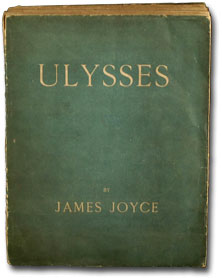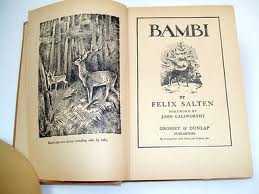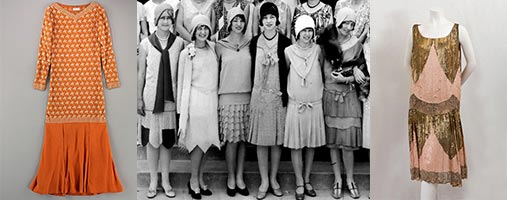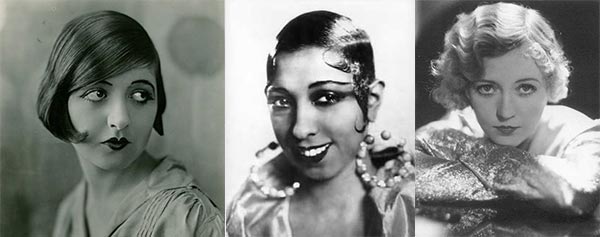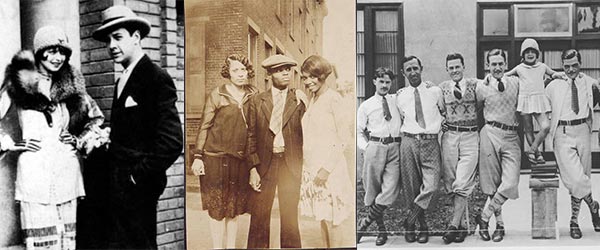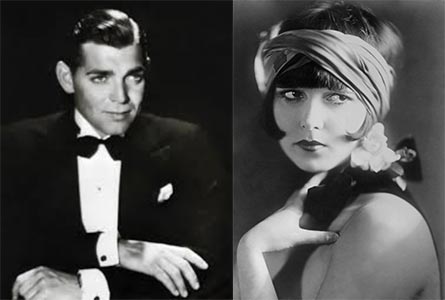It was during the The Roaring 20s that the first real celebrities began to appear, with the ever increasing popularity of cinema having a huge role to play.
Here’s a few of the most famous faces…
Gloria Swanson
Gloria Swanson was one of the most prominent stars during the silent film era and was one of the most sought after actresses in Hollywood. She was also one of the first fashion icons, and audiences would not only flock to see her films but also to see what she was wearing and try to copy her style. Her fashion, hair styles, and jewels were copied around the world – ornamented with beads, jewels, peacock and ostrich feathers, and other extravagant pieces haute couture of the day. She was one of the most photographed women in the world, with a commanding presence, despite being only a petit 5ft tall.
Swanson’s popularity waned during the 1930s and the introduction of the talkies. She made a comeback in the 1950s, starring in Sunset Boulevard, where, in a case of art imitating life, Swanson played Norma Desmond, a faded silent movie star, who falls in love with a young screenwriter and dreams of making a comeback. Swanson received her third Best Actress Oscar nomination for the role.
Charlie Chaplin
Still considered to be one of the most important figures in the history of cinema, English comic actor and filmmaker Charles Spencer Chaplin rose to fame during the 1920s.
Chaplin founded his own film distribution company in 1919 so that he would have complete control over the films he made and they would fit into his vision. His first feature-length picture was The Kid (1921), followed by A Woman of Paris (1923), The Gold Rush (1925), and The Circus (1928), all featuring his on screen ‘tramp’ persona. He continued to make silent films in the 1930s, refusing to move into sound.
Not only did Chaplin star in his films, he wrote, directed, produced, edited and scored most of them as well. The combination of slapstick and pathos, with a political and often autobiographical edge, struck a chord with audiences and he was a much-loved public figure.
In 1972 Chaplin received an Honorary Academy Award for “the incalculable effect he has had in making motion pictures the art form of this century” and he continues to be held in high regard to this day.
Josephine Baker
Once described as “the most famous woman in the world”, Josephine Baker was an American-born French dancer, singer and actress. Born in St. Louis, Missouri, but later becoming a citizen of France.
Baker’s childhood in St Louis was poor, but her talent and confidenence attracted the attention of the St Louis Chorus Vaudeville Show, and she joined aged 15. After a stint on Broadway, she headed to Paris in 1925, where she rose to fame as a performer and where she made her home.
Baker was the first African-American female to star in a major motion picture, to integrate an American concert hall, and to become a world famous entertainer. She refused to perform for segregated audiences in America, and is noted for her contributions to the Civil Rights Movement. She was also known for assisting the French Resistance during World War II and received the French military honour, the Croix de guerre.
Babe Ruth
George Herman “Babe” Ruth, Jr., nicknamed “the Bambino” and “the Sultan of Swat”, was an American professional baseball player and one of the first celebrity sportsmen.
He was known for his hitting brilliance, setting many records and was the first player to hit 60 home runs in one season, a mark not surpassed until 1961.
Ruth is credited with changing baseball itself. The popularity of the game exploded in the 1920s, largely due to his influence. He has since become regarded as one of the greatest sports heroes in American culture. Ruth’s legendary power and charismatic personality made him a larger than life figure in the “Roaring Twenties”, and according to ESPN, he was the first true American sports celebrity superstar whose fame transcended baseball. Off the field, he was famous for his charity contributions which included helping children to learn and play baseball, but also was noted for his often reckless lifestyle.
Coco Chanel
Founder of the Chanel Brand, Gabrielle Bonheur Chanel was the only fashion designer to appear on Time magazine’s list of the 100 most influential people of the 20th century.
Chanel is credited with liberating women from rigid corsets and petticoats and popularising the sportswear and casual chic that defined the look on the 1920s.
As early as 1915, Harper’s Bazaar raved over Chanel’s designs: “The woman who hasn’t at least one Chanel is hopelessly out of fashion … This season the name Chanel is on the lips of every buyer.”
She trademarked a look of youthful ease, confidence, liberated physicality and understated elegance in the post war era and is credited with the creation of iconic fashion items such as the “little black dress”, the Chanel Suit, naticual chic, and the Chanel Bag with its famous chain strap.
Check out our Pinterest board for The Roaring 20s, for more images and video clips










